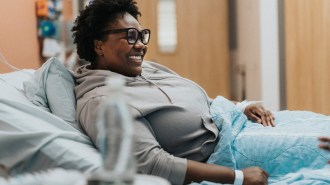Jarring Result: Extreme biking can hurt men’s fertility
Men who maintain grueling mountain-bicycling programs are apt to have lower sperm counts and more abnormalities of the scrotum than nonbikers are, a new study finds.

Using various measures, scientists in Austria compared the health of 40 male mountain bikers with that of 35 similar men who didn’t engage in so-called extreme biking. The volunteers ranged in age from 17 to 44 years.
The bikers spent more than 2 hours a day, 6 days a week, riding mountain trails. They logged roughly 3,000 miles a year. Recruited for the study from a biking club, these men had been riding mountain trails for 7 to 28 years.
Ultrasound examination revealed that 35 of the 40 bikers had injuries, mostly subtle, to their scrotums and testicles. Only 9 of the 35 nonbikers had such problems. In particular, 22 bikers but only 6 nonbikers had testicular cysts.
Physicians typically leave such cysts untreated unless they become larger than 3 centimeters in diameter. Only one study volunteer, a biker, had such a large cyst, which he had surgically removed after the study imaged it.
A third of the bikers, compared with none of the nonbikers, showed calcium deposits in their testicles, says study coauthor Ferdinand Frauscher, a radiologist at the University Hospital Innsbruck. Other studies have linked such calcification to increased risk of testicular cancer. The calcification seems to result from “repeated, chronic microtraumatization” of the scrotum that causes scarring of blood vessels inside the testicles, Frauscher reported at the Annual Meeting of the Radiological Society of North America in Chicago this week.
Semen samples from the participants revealed that bikers averaged 20 million sperm per milliliter of semen, compared with 47 million/ml in the nonbikers.
Higher scrotal temperatures during strenuous biking depress sperm making, Frauscher says. When viewed under a microscope, the bikers’ sperm were also significantly less mobile than the others’–possibly because of microtraumatization, he adds. Combined, heat and microtraumatization “might influence the fertility capacity of the mountain bikers,” Frauscher says.
It makes sense that repetitive injury to the scrotum from jolts of a mountain bike seat could induce cellular changes there, says radiologist Barry B. Goldberg of the Thomas Jefferson University in Philadelphia. “Radiologic imaging–particularly ultrasound–will be an ideal way to monitor the degree of trauma” from biking, he says.
Questionnaires filled out by the participants show that five of the bikers, but none of the nonbikers, had had problems sustaining erections.
Frauscher, who is a mountain biker himself, recommends that people buy bikes with shock absorbers and cushioned seats.
****************
If you have a comment on this article that you would like considered for publication in Science News, please send it to editors@sciencenews.org.
To subscribe to Science News (print), go to https://www.kable.com/pub/scnw/subServices.asp.
To sign up for the free weekly e-LETTER from Science News, go to http://www.sciencenews.org/subscribe_form.asp.







